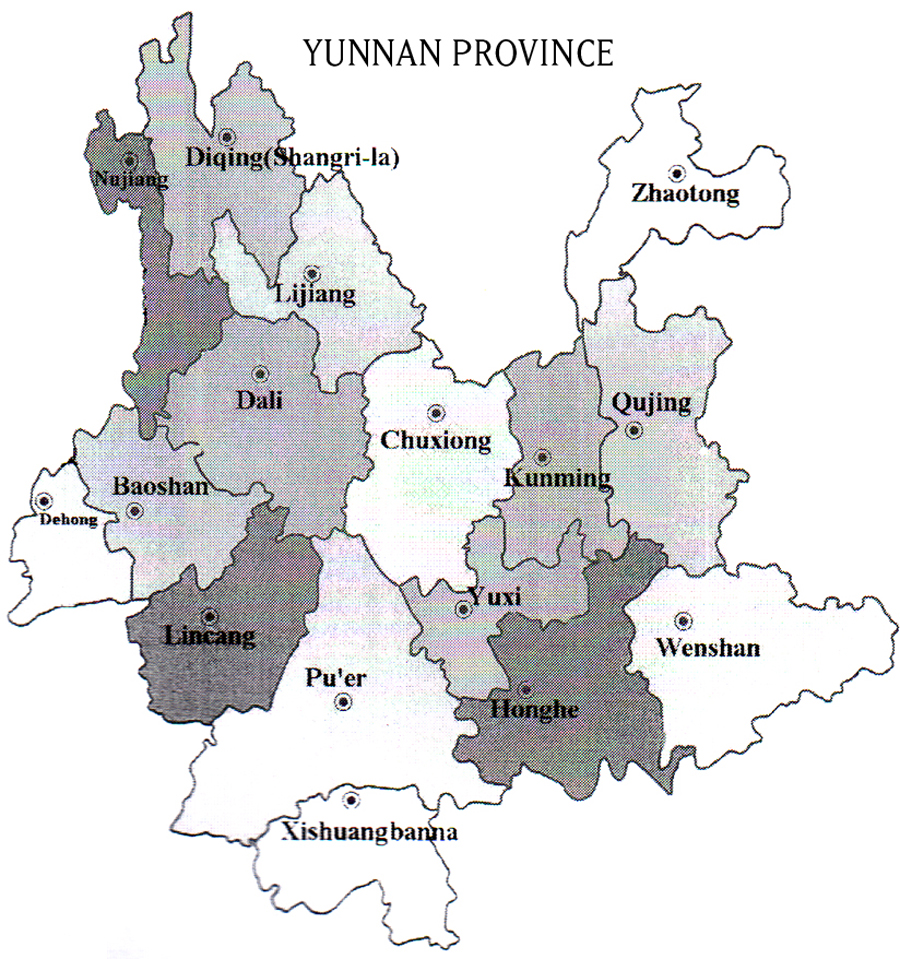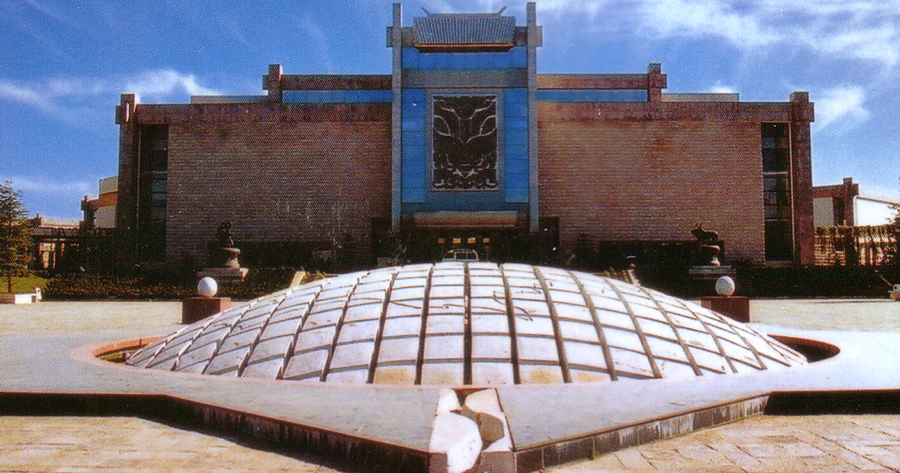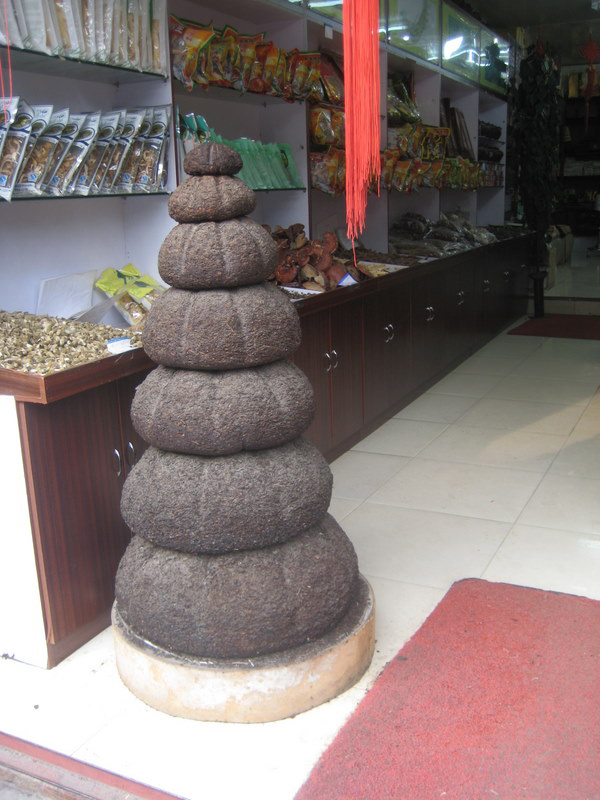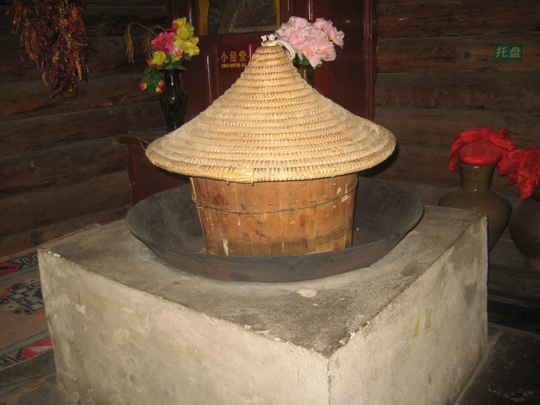
| What is Flavor and Fortune? |
| How do I subscribe? |
| How do I get past issues? |
| How do I advertise? |
| How do I contact the editor? |
Read 13030853 times
Connect me to:
| Home |
| Articles |
| Book reviews |
| Letters to the Editor |
| Newmans News and Notes |
| Recipes |
| Restaurant reviews |
| Article Index (all years, slow) |
| List of Article Years |
| Article Index (2025) |
| Article Index (last 2 years) |
| Things others say |
| Related Links |
| Log In... |
| Authors |
| Categories & Topics |
Yunnan: People, Places, and Culinary Pleasures, Part I
| by Jacqueline M. Newman |
Chinese Food in China, Hong Kong, and/or Taiwan
Spring Volume: 2012 Issue: 19(1) page(s): 5 - 10, and 19
 This southwestern province, home to the largest number of Chinese minority people in all of China, is not yet well known outside of China. A physically large province, it has more than one hundred fifty thousand square miles of land and some forty-six million people. The capital city, Kunming, known as the 'City of Eternal Spring' with great weather, has more than seven million inhabitants. It and smaller Yunnanese cities and towns were once isolated from the rest of China, but no more. Now, there are better roads and more of them, more bus, train, and air services, and more interactions with China and its leadership. This province has sixteen prefectures and large numbers of twenty-four different minority groups in residence, the largest number and the most different ethnic populations in any one province in China.
This southwestern province, home to the largest number of Chinese minority people in all of China, is not yet well known outside of China. A physically large province, it has more than one hundred fifty thousand square miles of land and some forty-six million people. The capital city, Kunming, known as the 'City of Eternal Spring' with great weather, has more than seven million inhabitants. It and smaller Yunnanese cities and towns were once isolated from the rest of China, but no more. Now, there are better roads and more of them, more bus, train, and air services, and more interactions with China and its leadership. This province has sixteen prefectures and large numbers of twenty-four different minority groups in residence, the largest number and the most different ethnic populations in any one province in China.
The food in Yunnan is known as Dian Cuisine. It is influenced by provincial neighbors including Sichuan and Guizhou, and is China's gateway to Vietnam, Laos, Myanmar, Thailand, Cambodia, and other Southeastern and South Asian countries. With these proximities and its large minority population, Yunnan has not only diversity of people, but also of flora, fauna, and fantastic food.
Folks come here to eat the best Crossing Bridge Rice Noodles and Steamed Chicken in Earthen Pot, a large variety of wild mushrooms, and many fruits, vegetables, and other different foods. In Yunnan one enjoys them and limitless menus while visiting historic relics and seeing and savoring foods neither looking nor tasting like what most think of as Chinese food. However, they are Chinese food indeed, related to the minorities and their neighbors.
This province has three cooking styles including a northern one with dried meats, vegetables, dairy products and many Muslim tastes. The second is a southeastern style incorporating many medicinal herbs in hot pots, Yunnan pots, and other one-dish delights. Third is a southwestern style influenced by what was Burma and now known as Myanmar. This influence incorporates lots of coconut, cloves, turmeric, palm sugar, and purple rice; many made into soups and stews.
Throughout Yunnan, tea is popular, and liked very strong. When green, it can include sunflower and melon seeds, peanuts, and fried peas--here known as iron peas. These are infused in the pot. When black, most often it is pu-er tea, but that tea can be found green, too. Both are oxidized twice and some call pu-er a fermented tea. One can also get good cups of coffee because the beans are local and luscious. One certainly sees dried and compressed pu-er tea everywhere. We found some for sale as were disks piled high, and others ready to be wall decor for restaurants and homes.
Available and loved, are street foods including roasted sweet and white potatoes, and a snack called er kuai, often eaten as a meal early in the day. Popular in and out of restaurants are pickled peppers and other pickled vegetables, fried cattle skin, curried dishes, cakes, dried meats used in stir-fries, split pea and fish soups, buns, rice jellies, and bamboo tubes stuffed with a plethora of different things. Also popular, is pineapple rice and sweet dishes often flavored with peanut powder.
Many come to Yunnan for a Shiping Bean Curd Banquet, their Jizong or their Mushroom Banquet, buckwheat jelly, Bean Curd Soup with Vegetables, Eight Treasures Boat which is more a cake, and Eight Treasures of Yunnan often called a cake but is an eight-part snack assembled in or with crispy rolls filled with items such as ham, pureed meat, roasted sesame seeds, roasted chopped peanuts, sauteed mushrooms, and one or more pickled vegetables. Others come for their Sweet Wine Lees Rice, Roast Fish with Fragrant Cogongrass, and many other well-known local foods. KUNMING is this province's capital city. While less modern than others in China, its is a good-size city of some seven million people. When visiting here, many remember it was on many a caravan route through South-east Asia. Not new, this city is more than two thousand years old, and General Chuang Qaio of the Chu Kingdom set up camp here near Dianchi Lake in 279 BCE. Then called the Dian Kingdom, the area was subjugated under the reign of Emperor Wu of Han in 109 BCE, and during the Han Dynasty (202 BCE - 220 CE), a city named Kunzhou was established a mite southwest of here.
Historians tell us Kunming was founded in 765 CE and known then as Tuodong. It was in the Kingdom of Nanzhao (737 - 902 CE). Later, circa 937, it became part of the Kingdom of Dali. During the Yuan/Mongol invasion in this region in 1252, about 1276 Mongol rulers called it Kunming County. Soon thereafter, it became the provincial capital of Yunnan. Scholars called this city Yachi Fu or Duck Pond Town. It was described by Marco Polo who traveled in the area in the 1300s. In the 19th century, its then city fathers built a wall around this city, they wanted it safe and permanent. When the French came to the region in the early 1900s, they built the Indochina Rail connecting Kunming to Hanoi; this still exists. In 1928, Kunming was elevated to a municipality. During World War II it was a target of the Japanese Imperial Air Force. When the Chinese lost the Burma road, an American volunteer fighter group, later known as the Flying Tigers, used the city as a base. They flew supplies in over the Himalayas from British bases in India and beyond over what was then called 'The Hump.' Soldiers, my uncle among them, flew with the pilots of the Flying Tigers providing support. Later, these Flying Tigers provided the design for the Kunming airport.
This laid-back city, now thriving, is now cosmopolitan and loaded with things to see and taste. Nearby is the Tiger Leaping Gorge, the bronze Jin Dian or Golden Temple, the Qiongzhu or Bamboo Temple, Lake Dian, and the Stone Forest, among other wonders worth seeing. There is a large Buddhist spot called Yuantong Si with an imposing Ming gateway and a golden statue of Maitreya Buddha, also a big bird and flower market. The old Muslim quarter is where wonderful wind-dried beef can be had, and see a thirteen story pagoda built in the Tang Dynasty. Here, one can also visit many museums and other delights. People here may be mainly minority Chinese, but they and the Han wear Guess Jeans and other western wear, and by face most are not recognizable as minorities; some not even as Chinese.
 Kunming is home to Yunnan Nationalities University (YNU), previously called the Yunnan Institute for the Nationalities. Founded and funded in 1951, it is located at the foot of Shangshan Hill near Lotus Pond. This first-rate institution, more than fifty-five years old, has graduated more than fifty thousand students who serve minority and Han populations throughout China, many as specialists in borderland studies.
Kunming is home to Yunnan Nationalities University (YNU), previously called the Yunnan Institute for the Nationalities. Founded and funded in 1951, it is located at the foot of Shangshan Hill near Lotus Pond. This first-rate institution, more than fifty-five years old, has graduated more than fifty thousand students who serve minority and Han populations throughout China, many as specialists in borderland studies.
Some in and outside of China see the people and the province as back-water, but they are wrong. They may have read about the Eighteen Oddities of Yunnan including flowers cooked as vegetables, straw hats as pot covers shown below, their Er Kuai, roasted ground glutinous rice cakes, milk cooked in sheets and eaten plain, fried, or roasted, their plain or stinky bean curd, and their raw eggs banded in straw and sold in a five-pack. However, they really did not meet or get to know the people nor did they taste their foods. That, and they never went to the Nationities Museum shown above and seen the exhibits, the teas including this huge pressed Pu-er and other teas and lots more there.
Kunming city sits at six thousand five hundred feet on the Yugai Plateau, and it does impress. It has friendly folk and fine street and banquet foods that range from traditional to modern. Though further from the United States than most places in China, more expensive to travel to as well, it has one of the mildest climates in China, is covered with blossoms and lush vegetation all year round, and is a place to enjoy for a myriad of reasons. Did these negative folk ever visit here? We did and now know much about it.
 Do they know that prices here are as lovely as the place? We certainly learned that! Four of us lived here for eight days for less than five hundred dollars, and that was for all of us. We visited the Yunnan Village of Minority Nationalities at 1503 Dianchi Road in Kunming; phone: 650228, and learned lots about their populations, even some of their oddities such as this pot cover. We went to many other places even wandered across the street from this village to visit the Yunnan Nationalities Museum. Their exhibits and bookstore are a must. Do save time for serious browsing there. The bookstore has a large number of volumes in English, many more in Chinese and other languages. Nowhere else in the world can one peruse so many books about Chinese minority populations in one huge room. We had a hard time controlling ourselves and only did so due to an already overly-heavy suitcase. We only purchased half dozen volumes but did make a list of three times that number for future acquisition.
Do they know that prices here are as lovely as the place? We certainly learned that! Four of us lived here for eight days for less than five hundred dollars, and that was for all of us. We visited the Yunnan Village of Minority Nationalities at 1503 Dianchi Road in Kunming; phone: 650228, and learned lots about their populations, even some of their oddities such as this pot cover. We went to many other places even wandered across the street from this village to visit the Yunnan Nationalities Museum. Their exhibits and bookstore are a must. Do save time for serious browsing there. The bookstore has a large number of volumes in English, many more in Chinese and other languages. Nowhere else in the world can one peruse so many books about Chinese minority populations in one huge room. We had a hard time controlling ourselves and only did so due to an already overly-heavy suitcase. We only purchased half dozen volumes but did make a list of three times that number for future acquisition.
In both of these places we learned lots about the local people in Kunming and the entire province. We learned about their street foods and banquet beauties, and about the people themselves and their lifestyles. We are now better able to appreciate them, their places, and their culinary pleasures.
In Kunming we did breakfast on Er Kuai and did enjoy the ones made with purple rice. These glutinous rice-flour pancakes come wrapped around a you tiao or fried cruller. Before getting one, the staff lathers it with fermented red tofu and other seasonings. The cost is forty cents apiece, and one makes a large breakfast or fine lunch. We also enjoyed dumplings for breakfast, some served in a soup with lots of greens, a bowl costing not quite twice of the Er Kuai. One of us had a mala rice, another a sweet potato noodle soup with jiaozi, pickled vegetables and fresh greens; that was six bitsless. We enjoyed many main meals made with meat, fish, and/or noodles. All were yummy, most cost a literal couple of bucks, and lunch or dinner for the four of us was always less than twenty and often more than we could finish.
We had Crossing Bridge Rice Noodles in a restaurant specializing in same, it is reviewed in this issue, and enjoyed Steam Chicken in Earthen Pot in another. This dish is sometimes called Chicken in Yunnan Pot, and here it is known as Qiguoji. The pot is always ceramic, and most often has an internal chimney. In both these dishes we loved the xuan wei huo tui, the famous Yunnan Ham.
We also ate in a Muslim restaurant, another time in a Dai one, and in several Bai eateries; a handful are reviewed in this issue. On the street we tried Sweet Corn Fritters and some honey-filled flatbread. Every item was tasty, except for one that was too salty. Do read about several of the places we tried and you can taste the dishes vicariously. Then travel to Yunnan and taste them for real; you will be glad you did.
Bedding down was about the same cost as a main meal, but for a room for two. The rooms were spotless and each one had bathroom and shower. Clearly we enjoyed their prices, all the foods we had, and our other experiences. We recommend visiting Yunnan, also the Bai minority near and at Lake Erhai, as we did. More about the people, places, and the culinary pleasures of the Bai and Dai in the next issue.
Banquets, we must admit, were a bargain, too. For one hundred to one hundred fifty dollars, one could feed a dozen hungry sophisticated diners. The banquet foods looked and tasted better than most banquet experiences in the United States, many included more food, too. So what are you waiting for?
Never mind our prattle, just keep in mind that some food in Yunnan is spicy, made that way using pickled chili peppers. Some served at room temperature. Much is influenced not only by the minorities here, but also by provinces nearby. We had one banquet beauty in a gorgeous Qing Dynasty building in a restaurant owned by Li Mengzi. Once a journalist, in Chinese he wrote Delicacy in Kumning which is about restaurants in Kunming. More about Yunnan and two of their ethnic populations, the Dai and Bai, and about Dali and their foods in the next issue of Flavor and Fortune. In the meantime, try a few of their dishes whose recipes are below. One can substitute Smithfield ham for Yunnan ham; we have never located Yunnan ham in the United States; if you have, please advise.
| Crossing Bridge Noodles II |
|---|
3 cups chicken broth 3 Tablespoons minced scallions 1 brown bean curd, thinly sliced then cut into strips 2 Tablespoons oil or hot oil 1 or more cups vegetable pieces of your choice 1/2 teaspoon salt 8 thin slices of meat, pork, beef or another optional: slices of fish, pepper powder, fresh coriander 1 cup precooked rice noodles Preparation: 1. Bring chicken broth to the boil, add the salt, scallions, bean curd, and the oil. 2. Add slices of meat and vegetables, the optional ingredients, and the rice noodles, then serve. |
| Chicken Steamed in a Yunnan Pot II |
|---|
1 two to three pound chicken, cut into eight to ten pieces through the bones 2 ounces boneless Yunnan ham, thin sliced 3 ounces canned bamboo shoots, cut into chunks 2 scallions, sliced 6 slices fresh ginger 10 pitted Chinese brown dates, soaked for half hour 1/2 teaspoon salt 1/2 teaspoon sugar 3 Tablespoons rice wine 1/2 teaspoon chili oil or up to three seeded picked chilies, optional Preparation: 1. Blanch the chicken for one minute, then drain and put it into a Yunnan pot. 2. Add ham, scallions, ginger, dates, salt, sugar, and the rice wine, and two cups water, and the chili oil or the chili peppers, if desired. Cover and steam for two hours over slowly boiling water. 3. Remove form the steamer, remove the cover of the Yunnan pot and add more salt, if needed. Recover it, carry it to the table and set it on a hot tile or trivet, and serve. |
| Pickled Chilies II |
|---|
4 cups small chili peppers, rinsed with boiling water 2 cups rice vinegar 3/4 cups granulated sugar 2 Tablespoons coarse salt 4 whole star anise 8 Sichuan peppercorns Preparation: 1. Sterilize four half-pint canning jars, their covers, and their lids. 2. Dry the chili peppers, then remove their stems but do not cut into the peppers. 3. In an enamel or another non-reactive pot, add the vinegar, sugar, and salt and heat until the sugar is totally dissolved, then bring to the boil and allow to cool somewhat. 4. Pack the chili peppers into the jars, add one star anise and two Sichuan peppercorns into each jar. Pour warm prepared liquid over the chil peppers and jiggle the jars so that all bubbles rise to the top before sealing them tightly. Invert them for two minutes, then right them and set aside in a draft-free place until completely cool. Then set aside for at least two weeks before using them. |

Copyright © 1994-2025 by ISACC, all rights reserved
Address
3 Jefferson Ferry Drive
S. Setauket NY 11720